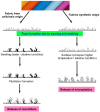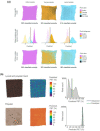Environmentally Friendly Approach to the Reduction of Microplastics during Domestic Washing: Prospects for Machine Vision in Microplastics Reduction
- PMID: 37505540
- PMCID: PMC10385959
- DOI: 10.3390/toxics11070575
Environmentally Friendly Approach to the Reduction of Microplastics during Domestic Washing: Prospects for Machine Vision in Microplastics Reduction
Abstract
The increase in the global population is directly responsible for the acceleration in the production as well as the consumption of textile products. The use of textiles and garment materials is one of the primary reasons for the microfibers generation and it is anticipated to grow increasingly. Textile microfibers have been found in marine sediments and organisms, posing a real threat to the environment as it is invisible pollution caused by the textile industry. To protect against the damaging effects that microplastics can have, the formulation of mitigation strategies is urgently required. Therefore, the primary focus of this review manuscript is on finding an environmentally friendly long-term solution to the problem of microfiber emissions caused by the domestic washing process, as well as gaining an understanding of the various properties of textiles and how they influence this problem. In addition, it discussed the effect that mechanical and chemical finishes have on microfiber emissions and identified research gaps in order to direct future research objectives in the area of chemical finishing processes. In addition to that, it included a variety of preventative and minimizing strategies for reduction. Last but not least, an emphasis was placed on the potential and foreseeable applications of machine vision (i.e., quantification, data storage, and data sharing) to reduce the amount of microfibers emitted by residential washing machines.
Keywords: chemical finishing; data sharing; machine-vision; mechanical finishing; microfibers; microplastics; supply chain; sustainability; textile.
Conflict of interest statement
The authors declare no conflict of interest.
Figures














Similar articles
-
Microfiber Emissions from Functionalized Textiles: Potential Threat for Human Health and Environmental Risks.Toxics. 2023 Apr 24;11(5):406. doi: 10.3390/toxics11050406. Toxics. 2023. PMID: 37235219 Free PMC article. Review.
-
Microfiber pollution: Assessment, emission estimation, and time-series-based forecast of microfibers from domestic washing machine laundering and mitigation measures.Integr Environ Assess Manag. 2024 Nov;20(6):2116-2127. doi: 10.1002/ieam.4985. Epub 2024 Aug 26. Integr Environ Assess Manag. 2024. PMID: 39185940
-
Synthetic textile and microfiber pollution: a review on mitigation strategies.Environ Sci Pollut Res Int. 2021 Aug;28(31):41596-41611. doi: 10.1007/s11356-021-14763-z. Epub 2021 Jun 8. Environ Sci Pollut Res Int. 2021. PMID: 34100210 Review.
-
Quantification and morphological characterization of microfibers emitted from textile washing.Sci Total Environ. 2022 Aug 1;832:154973. doi: 10.1016/j.scitotenv.2022.154973. Epub 2022 Apr 1. Sci Total Environ. 2022. PMID: 35367554
-
Microfiber release from different fabrics during washing.Environ Pollut. 2019 Jun;249:136-143. doi: 10.1016/j.envpol.2019.03.011. Epub 2019 Mar 8. Environ Pollut. 2019. PMID: 30884392
Cited by
-
Investigate the Processability of Biobased Thermoplastics Used in Nonwoven Fabrics.ACS Polym Au. 2024 Jun 19;4(5):405-419. doi: 10.1021/acspolymersau.4c00023. eCollection 2024 Oct 9. ACS Polym Au. 2024. PMID: 39399888 Free PMC article.
-
Cellulose Fiber with Enhanced Mechanical Properties: The Role of Co-Solvents in Gel-like NMMO System.Gels. 2024 Sep 23;10(9):607. doi: 10.3390/gels10090607. Gels. 2024. PMID: 39330209 Free PMC article.
References
-
- Yarsley V.E., Couzens E.G. Plastics. 1st ed. Penguin Books Limited; London, UK: 1945.
-
- Statista Production of Textile Fibers Worldwide from 1975 to 2020, with a Forecast for 2025 and 2030 (in Million Metric Tons) 2022. [(accessed on 17 June 2021)]. Available online: https://www.statista.com/statistics/1250985/global-textile-fiber-product...
-
- Preferred Fiber & Materials Market Report. 2022. [(accessed on 16 January 2023)]. Available online: https://textileexchange.org/knowledge-center/reports/preferred-fiber-and...
Publication types
LinkOut - more resources
Full Text Sources

